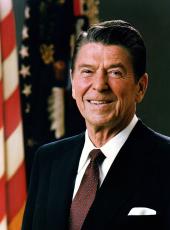
Statement on Soviet-United States Intermediate-Range Nuclear Force Reduction Negotiations
Today marks the opening of the next session of negotiations between the United States and the Soviet Union on intermediate-range nuclear forces, one of the three elements of the nuclear and space talks in Geneva. The United States returns to these negotiations determined to build on the progress made during Secretary Shultz' meetings in Moscow last week. Although a number of central issues require resolution and much remains to be negotiated, prospects for an INF agreement have moved forward.
The basic structure of an INF agreement-the nature and level of LRINF missile reductions—was agreed upon by General Secretary Gorbachev and myself at Reykjavik and is reflected in the draft treaty text presented by U.S. negotiators last month. This calls for reductions to an interim global ceiling of 100 warheads each on U.S. and Soviet land-based longer range INF missiles, with none in Europe, along with concurrent global constraints at equal levels on shorter range INF missiles and provisions for effective verification. The United States and our NATO Allies continue, however, to prefer a zero LRINF outcome—the elimination of this entire class of missiles.
One of the central issues remaining to be resolved is that of shorter range INF missile systems. We and our allies have long sought appropriate global constraints on SRINF in an initial INF agreement. The Soviets earlier agreed that they would include constraints on SRINF in an initial INF agreement, but they now appear to wish to deal with SRINF both within an INF agreement and in a separate negotiation. During Secretary Shultz' recent meetings in Moscow, the Soviets made explicit that their position in separate SRINF negotiations would be a zero outcome, and they suggested that this would be on a global basis. Much of the Soviet position remains to be elaborated, however, and we hope this will be done during the coming round. Meanwhile, we are already consulting closely with our allies on this issue and are in touch with congressional leaders as well.
It is U.S. and allied determination to maintain our security, which I continue to view as indivisible, that has given us this opportunity to achieve an historic agreement which, for the first time, would actually reduce nuclear weapons. Ambassador Glitman and the members of the U.S. delegation have been doing a fine job in this endeavor, and they continue to have my strongest support.
Verification is another central issue that must be resolved. We cannot make progress on this fundamental issue until the Soviets respond in detail to the comprehensive verification proposals which the United States has already made in Geneva. Verification would be facilitated if the Soviets were to accept a global zero outcome for LRINF. This is the preferred outcome of the United States and our allies, and we will continue to seek Soviet agreement to it.
As we return to these talks, we are hopeful but also realistic. We know that there are a number of issues whose resolution will demand considerable hard bargaining. But, working closely with our allies in Europe and Asia, we are ready to do our part and hope that the Soviets are returning to the table with similar resolve.
Ronald Reagan, Statement on Soviet-United States Intermediate-Range Nuclear Force Reduction Negotiations Online by Gerhard Peters and John T. Woolley, The American Presidency Project https://www.presidency.ucsb.edu/node/252645
